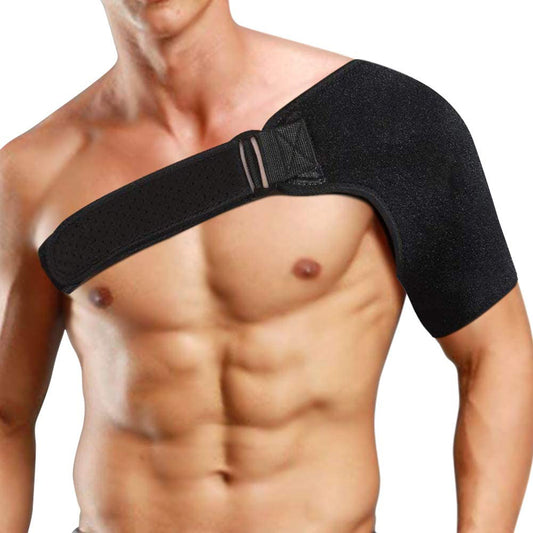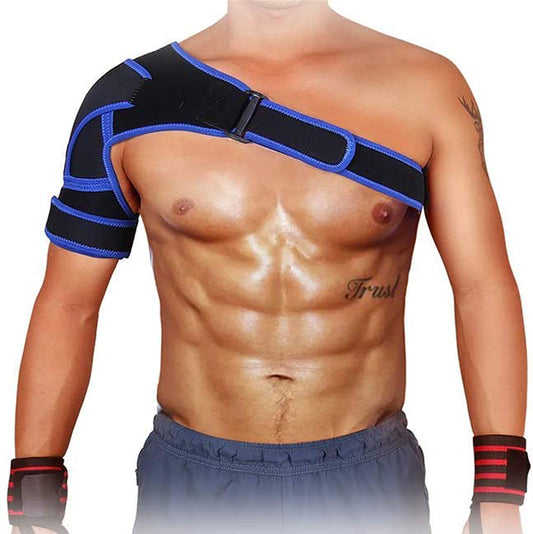-
Shoulder Brace for Men and Women for Torn Rotator Cuff Support,Tendonitis, Dislocation, Bursitis, Neoprene Shoulder Compression Sleeve Wrap
Regular price $16.99 USDRegular price$25.99 USDSale price $16.99 USDSale -
Tourmaline Warm Brace Self Heating Massage Belt for Neck Shoulder Support Brace
Regular price $21.99 USDRegular price$21.99 USDSale price $21.99 USD -
Compression Shoulder Support Brace, Adjustable Neoprene Upper Arm and Shoulder Wrap Pain Relief for Rotator Cuff Shoulder Tear Injury AC Joint Dislocation Prevention and Recovery
Regular price $26.99 USDRegular price$39.00 USDSale price $26.99 USDSale -
Shoulder Brace Adjustable Rotator Cuff Support for Men or Women Breathable Neoprene Compression Sleeve Wrap Left or Right Shoulder Medium
Regular price $36.99 USDRegular price$36.99 USDSale price $36.99 USD -
Compression Recovery Shoulder Brace - Adjustable Fit Sleeve Wrap Men Women. Relief for Shoulder Injuries, Tendonitis
Regular price $26.99 USDRegular price$39.00 USDSale price $26.99 USDSale -
Shoulder Support Brace for Men and Women Athletic | Orthopedic Care Shoulder Brace for Torn Rotator Cuff
Regular price $26.99 USDRegular price$39.00 USDSale price $26.99 USDSale
Collection: Optimize Shoulder Health: Discover the Best Compression Support Braces for Shoulder Injuries and Pain Relief
Optimize Your Shoulder Health with Our Premium Support Braces
Shoulder injuries and pain can significantly impact your daily life, making it essential to find effective solutions that support recovery and offer relief. Our high-quality shoulder braces are meticulously designed to cater to a range of needs, from everyday discomfort to serious injuries requiring stabilization and support.
Who Needs a Shoulder Brace?
1. Athletes:
- If you're an athlete engaged in sports that strain the shoulder joint, like tennis, baseball, or weightlifting, a shoulder brace can offer essential support and minimize the risk of injury.
2. Individuals with Previous Shoulder Injuries:
- Those recovering from injuries such as rotator cuff tear, dislocations, or labral tears may find shoulder braces vital in immobilizing and stabilizing the joint to prevent further damage.
3. Those Experiencing Chronic Pain:
- People suffering from shoulder arthritis or tendonitis may benefit from the consistent support that a shoulder brace offers, which can enhance mobility and manage pain effectively.
Why Do You Need a Shoulder Brace?
Using a shoulder brace can provide multiple benefits:
- Injury Prevention: By supporting the shoulder, braces can help prevent injuries in high-risk activities.
- Pain Relief: Compression from the brace can relieve pain caused by conditions like tendonitis and arthritis. Learn about our adjustable fit sleeve wrap designed for relief from shoulder injuries and tendonitis.
- Enhanced Recovery: Post-injury, a shoulder brace can expedite recovery by restricting harmful movements and maintaining proper joint alignment.
- Increased Stability: Especially after surgery, a brace stabilizes the shoulder to aid in faster and safer recovery.
How to Recognize if a Shoulder Brace is Right for You
Consider using a shoulder brace if:
- You've sustained a recent injury. The support can prevent exacerbation and ease the recovery process.
- You're in an occupation or sport that involves repetitive shoulder movements. Helps reduce the risk of developing conditions like impingement syndrome.
- You experience chronic shoulder pain or discomfort. Compression and stabilization can provide relief and support your day-to-day activities. Check out our neoprene wrap for rotator cuff tears and AC joint dislocation prevention and recovery.
Features of Our Shoulder Braces
Our shoulder braces are designed with the following features to ensure optimal performance and comfort:
- Adjustable Fit: Ensures a snug fit for diverse body shapes and sizes.
- Breathable Materials: Made with lightweight neoprene, our braces provide warmth without compromising on breathability, facilitating all-day wear.
- Easy-to-use Straps: Enable you to secure the brace conveniently without needing additional assistance.
- Versatile Design: Suitable for both left and right shoulders, integrating effortless into your lifestyle. Explore our breathable compression sleeve designed for both men and women.
Common Questions about Using Shoulder Braces
1. Can shoulder braces be worn during sports?
Yes, many of our braces are designed to offer support during sports and physical activities without restricting movement.
2. How long should I wear a shoulder brace each day?
The duration can vary based on your specific condition, but generally, a few hours a day while engaging in physically demanding tasks or activities is advisable.
3. Are there any limitations while wearing a shoulder brace?
It is recommended to avoid activities that exacerbate pain or strain the shoulder excessively while a brace provides support.
4. Do they require special cleaning?
Most braces can be cleaned with a damp cloth for daily upkeep and should be fully washed according to the product instructions periodically.
Benefits of Using Our Shoulder Braces
The benefits of using our carefully designed shoulder braces extend beyond immediate pain relief:
- Encourages Muscle Support and Joint Alignment.
- Promotes Healing by Restricting Injurious Movements.
- Provides Psychological Relief through the Assurance of Support.


We, the ZSZBACE brand, have years of experience in manufacturing and R&D, ensuring superior materials and professional service. Trust in our expertise to provide shoulder support that not only offers relief but also contributes significantly to improving your overall function and quality of life.






